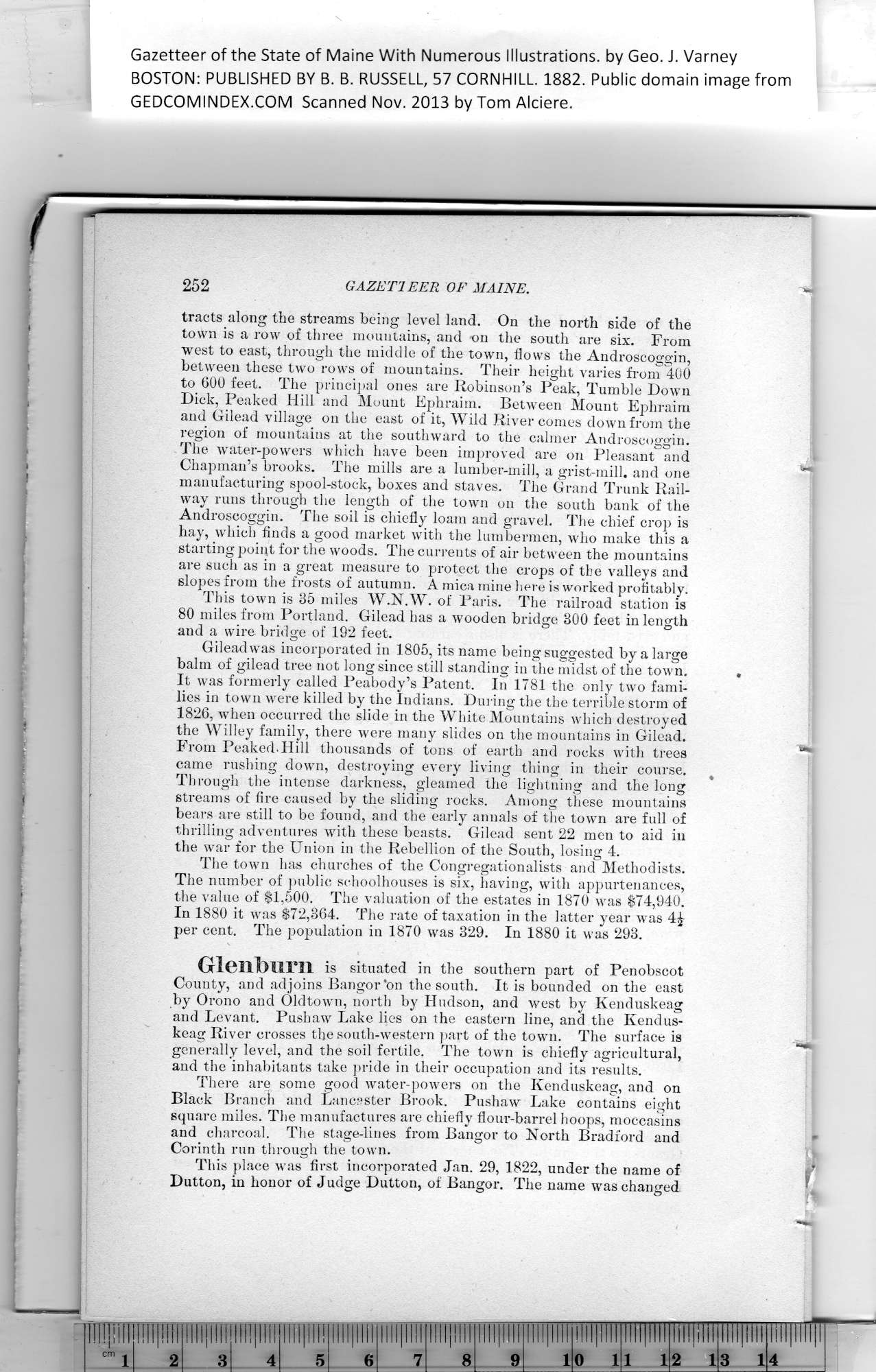|
Gazetteer of the State of Maine With Numerous Illustrations, by Geo. J. Varney
BOSTON: PUBLISHED BY B. B. RUSSELL, 57 CORNHILL. 1882. Public domain image from
252 GAzETl EER OF MAINE.
tracts along the streams being level land. On the north side of the
town is a row of three mountains, and on the south are six. From
west to east, through the middle of the town, flows the Androscoggin,
between these two rows of mountains. Their height varies from 400
to 600 feet. The principal ones are Robinson’s Peak, Tumble Down
Dick, Peaked Hill and Mount Ephraim. Between Mount Ephraim
and Gilead village on the east of it, Wild River comes down from the
region of mountains at the southward to the calmer Androscoggin.
The water-powers which have been improved are on Pleasant and
Chapman’s brooks. The mills are a lumber-mill, a grist-mill, and one
manufacturing spool-stock, boxes and staves. The Grand Trunk Rail-
way runs through the length of the town on the south bank of the
Androscoggin. The soil is chiefly loam and gravel. The chief crop is
hay, which finds a good market with the lumbermen, who make this a
starting point for the woods. The currents of air between the mountains
are such as in a great measure to protect the crops of tbe valleys and
slopes from the frosts of autumn. A mica mine here is worked profitably.
This town is 35 miles W.N.W. of Paris. The railroad station is
80 miles from Portland. Gilead has a wooden bridge 300 feet in length
and a wire bridge of 192 feet.
Gileadwas incorporated in 1805, its name being suggested by a large
balm of gilead tree not long since still standing in the midst of the town.
It was formerly called Peabody’s Patent. In 1781 the only two fami-
lies in town were killed by the Indians. During the the terrible storm of
1826, when occurred the slide in the White Mountains which destroyed
the Willey family, there were many slides on the mountains in Gilead.
From Peaked.Hill thousands of tons of earth and rocks with trees
came rushing down, destroying every living thing in their course.
Through the intense darkness, gleamed the lightning and the long
streams of fire caused by the sliding rocks. Among these mountains
bears are still to be found, and tbe early annals of the town are full of
thrilling adventures with these beasts. Gilead sent 22 men to aid in
the war for the Union in the Rebellion of the South, losing 4.
The town has churches of the Congregationalists and Methodists.
The number of public schoolhouses is six, having, with appurtenances,
the value of $1,500. The valuation of the estates in 1870 was $74,940.
In 1880 it was $72,364. The rate of taxation in the latter year was 4£
per cent. The population in 1870 was 329. In 1880 it was 293.
Glenbum is situated in the southern part of Penobscot
County, and adjoins Bangor'on the south. It is bounded on the east
by Orono and Oldtown, north by Hudson, and west by Kenduskeag
and Levant. Pusbaw Lake lies on the eastern line, and the Kendus-
keag River crosses the south-western part of the town. The surface is
generally level, and the soil fertile. The town is chiefly agricultural,
and the inhabitants take pride in their occupation and its results.
There are some good water-powers on the Kenduskeag, and on
Black Branch and Lancaster Brook. Pushaw Lake contains eight
square miles. The manufactures are chiefly flour-barrel hoops, moccasins
and charcoal. The stage-lines from Bangor to North Bradford and
Corinth run through the town.
This place was first incorporated Jan. 29, 1822, under the name of
Dutton, in honor of Judge Dutton, of Bangor. The name was changed
PREVIOUS PAGE ... NEXT PAGE
This page was written in HTML using a program written in Python 3.2
|
